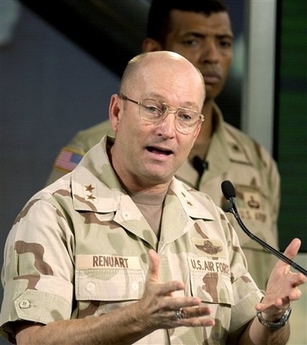General: Al-Qaida making new cells in US
(AP)Updated: 2007-07-25 16:31
WASHINGTON - A top US military commander said Tuesday he believes there are al-Qaida cells in the United States - or people working to create them - and the military needs to triple its response teams to counter a growing threat of attack.
 US Air Force Gen. Gene Renuart, gestures during a news conference at Central Command Center, Doha, Qatar in this April 10, 2003 file photo. [AP]  |
Air Force Gen. Victor "Gene" Renuart, who heads US Northern Command, said that as the terrorism threat within the nation's boundaries has increased officials have strengthened intelligence sharing, particularly in an effort to shore up security at ports.
"I believe there are cells in the United States, or at least people who aspire to create cells in the United States," Renuart said in an interview with The Associated Press. "To assume that there are not those cells is naive and so we have to take that threat seriously."
As for attacks, he added: "Am I concerned that this will happen this summer? I have to be concerned that it could happen any day."
Other US officials said last week they did not know of al-Qaida cells in the United States.
Renuart, who took over at US Northern Command just four months ago, said the military has one brigade-size unit available to respond to nuclear, chemical and biological incidents at home. That number, he said, needs to grow to three. A brigade is about 3,500 troops.
Renuart's comments came in the wake of a national intelligence report released last week, which concluded that al-Qaida is using its growing strength in the Middle East to plot attacks on US soil. The general is in Washington this week to attend meetings with Defense Secretary Robert Gates, Joint Chiefs Chairman Gen. Peter Pace, and a number of other top military commanders.
Port security has long been identified as a key weak point for terror attacks, including the need to scan cargo containers coming into the country by ship.
Renuart said officials are expanding their use of sensors and other technologies that allow them to track ships, including their location, their speed and other commercial information. And, while he would not provide details, he said there has already been "real payback" in terms of identifying vessels of concern and either checking or boarding them well before they entered US waters.
In addition, he said he is increasing the number of Coast Guard personnel assigned to US Northern Command to help during port security incidents or hurricanes. Currently there are 20 active duty personnel, and a new team of five reservists was created in April. Another five reservists are being added to that team by the end of the year.
"Because the national intelligence estimate talks about the vulnerability of ports, and because of the importance that we place on the movement of a variety of goods through those ports, finding ways to improve that is a really important element of our day-to-day work," Renuart said.
Improving communications between federal agencies and among emergency responders - including intelligence, homeland security and defense - has been an ongoing struggle. Officials identified significant communications failures during the Sept. 11, 2001, terrorist attacks and found that there were continuing problems during the hurricanes that devastated the Gulf Coast in August 2005.
Renuart said he has been working to improve the interaction between his office and the other intelligence agencies to ensure that information on terror threats is shared. That way, he said, the military will better be able to anticipate how terrorists might try to take advantage of any gaps or weaknesses in the system.
At the same time, he said it will be at least two years before he is able to pull together the military units he needs to better respond to a chemical, biological or nuclear disaster in the US
The units, he said, could include active duty, reserves or National Guard troops. And while portions of the brigades will be located in different states, they will be expected to train together and to be able to respond quickly to a disaster.
They would largely be made up of support forces, such as evacuation, medical, logistics and transportation troops. The Pentagon has been working since last year to identify units to be part of the brigade-size response teams.
Overall, Renuart said that as the terror threat has increased, the nation's ability to detect problems has also improved.
The intelligence report, he said, is a "summary of drumbeats, and the drumbeats are getting more prevalent out there. You cannot afford to ignore that." But, he said, a few years ago the nation was not as able to hear and interpret those drumbeats.
|
|
|
||
|
||
|
|